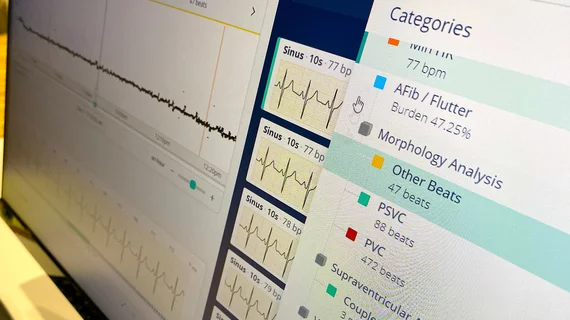AI correctly IDs ventricular arrhythmias in 88% of patients with sustained VT
An artificial intelligence (AI) algorithm that analyses electrocardiograms (ECG) correctly identified patients at near-term risk of life-threatening sustained ventricular tachycardia (VT) who could potentially benefit from pre-emptive interventions to prevent sudden cardiac death (SCD). This late-breaking clinical study presented Heart Rhythm 2023 used AI to examine single-lead ECGs as a screening tool that may offer physicians a new approach to sudden cardiac arrest risk management.[1]
"Current methods for predicting SCD are extremely limited. By leaning on artificial intelligence, we hope to revolutionize the way physicians monitor, prevent and predict SCD, improving the lives of patients while generating cost savings for our healthcare system," Laurent Fiorina, MD, with the Institut Cardiovasculaire Paris Sud in France, said in a statement. He has been directly involved with the development of this AI algorithm. "For high-risk patients who suffer from multiple conditions including hypertension, obesity, older age and diabetes, this technology could be lifesaving to help more accurately predict sustained VT and offer physicians important insights to offer early SCD prevention interventions."
SCD, caused by the sudden onset of arrhythmias that cause cardiac arrest, accounts for half of all cardiovascular deaths worldwide.[2] SCD typically occurs less than one hour from the onset of symptoms, and sometimes among individuals without any known prior conditions.[3] VT, which commonly occurs in patients with structural heart disease, can be associated with an increased risk of SCD.[4] Because traditional mechanisms for predicting and preventing mid- and long-term SCD are limited, this study sought to understand if AI could be leveraged to better identify near-term occurrences of VT using data from Holter ECG recordings.
The authors of this study developed a deep learning-based model with vendor Cardiologs using the first 24 hours of extended Holter monitor recordings, a type of portable electrocardiogram, to predict the risk of sustained (≥30 sec) ventricular tachycardia (VT) over two weeks. The model used 78,294 unselected Holter recordings collected across the U.S., U.K., France, Czech Republic, South Africa and India. Among 59,302 recordings used for validation, the mean age of patients were 61.3 ± 17.3 years and 40% were male. The study found 222 recordings presented sustained VT with a mean rate of 157 ± 38 bpm, and median duration 62 seconds [IQR 42, 173]), with the vast majority (98%) being monomorphic.
On the internal validation dataset, the model achieved an area under the curve (AUC - an aggregate measure of performance across all possible classification thresholds) of 0.939, with a sensitivity of 83.3% and a specificity of 88.7%. On the external validation dataset, the AUC was 0.911 with a sensitivity and specificity of 78.9% and 81.4%, respectively. The authors said the AI-model correctly predicted VT occurrence in 88% of patients with rapid VT (≥180 bpm). The reference model also revealed an internal validation AUC of 0.833.
Co-author Jagmeet Singh, MD, professor of medicine at Harvard Medical School and director of the Resynchronization and Advanced Cardiac Therapeutics Program at Mass General Hospital, said the technology may help revolutionize predictive risk models for patients based on just a day's worth of data collected from a wearable heart monitor.
"Early prediction is going to be key, because it allows us to put into place preventive strategies," Singh explained. "The deep-learning algorithms are able to pick up signals within the surface EKGs that the human eye cannot see and predict which patients are going to develop arrhythmias, whether they are atrial fibrillation or ventricular tachycardia."
The authors are currently looking to validate the model in future prospective clinical studies. They would also like to extend near-term prevention through ECG monitoring to hospital monitoring or wearable sensors with potential applicability to larger populations.

